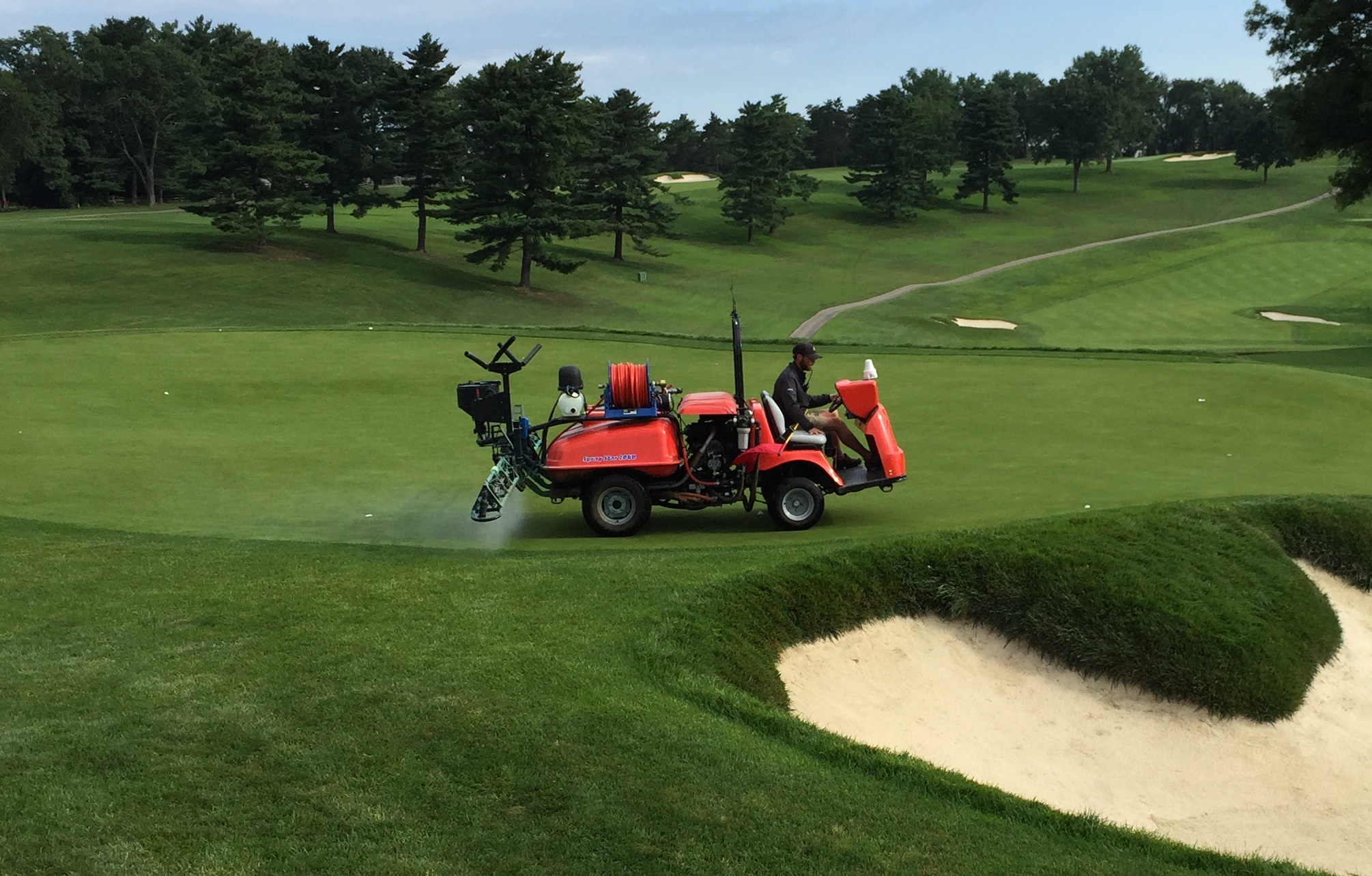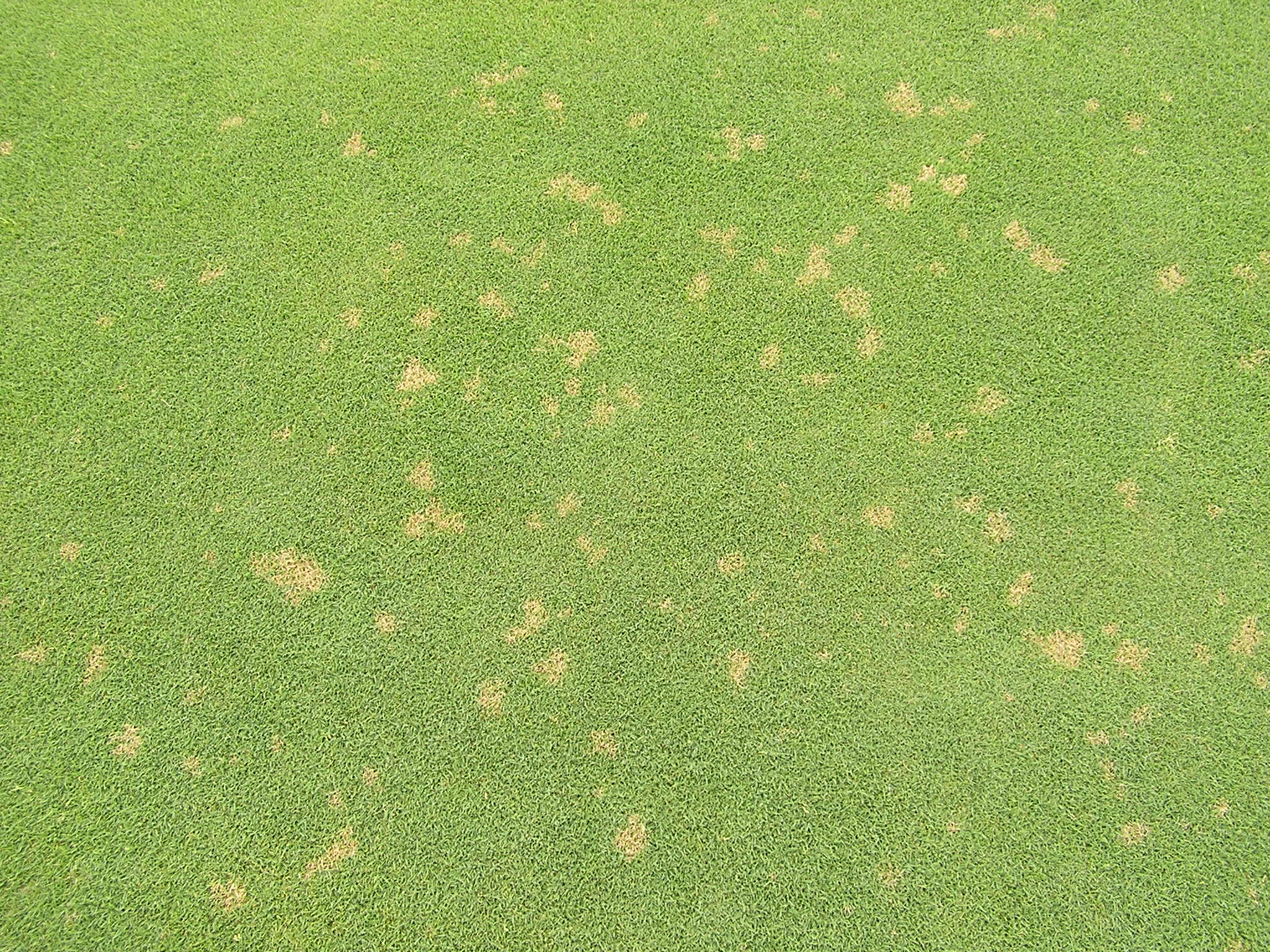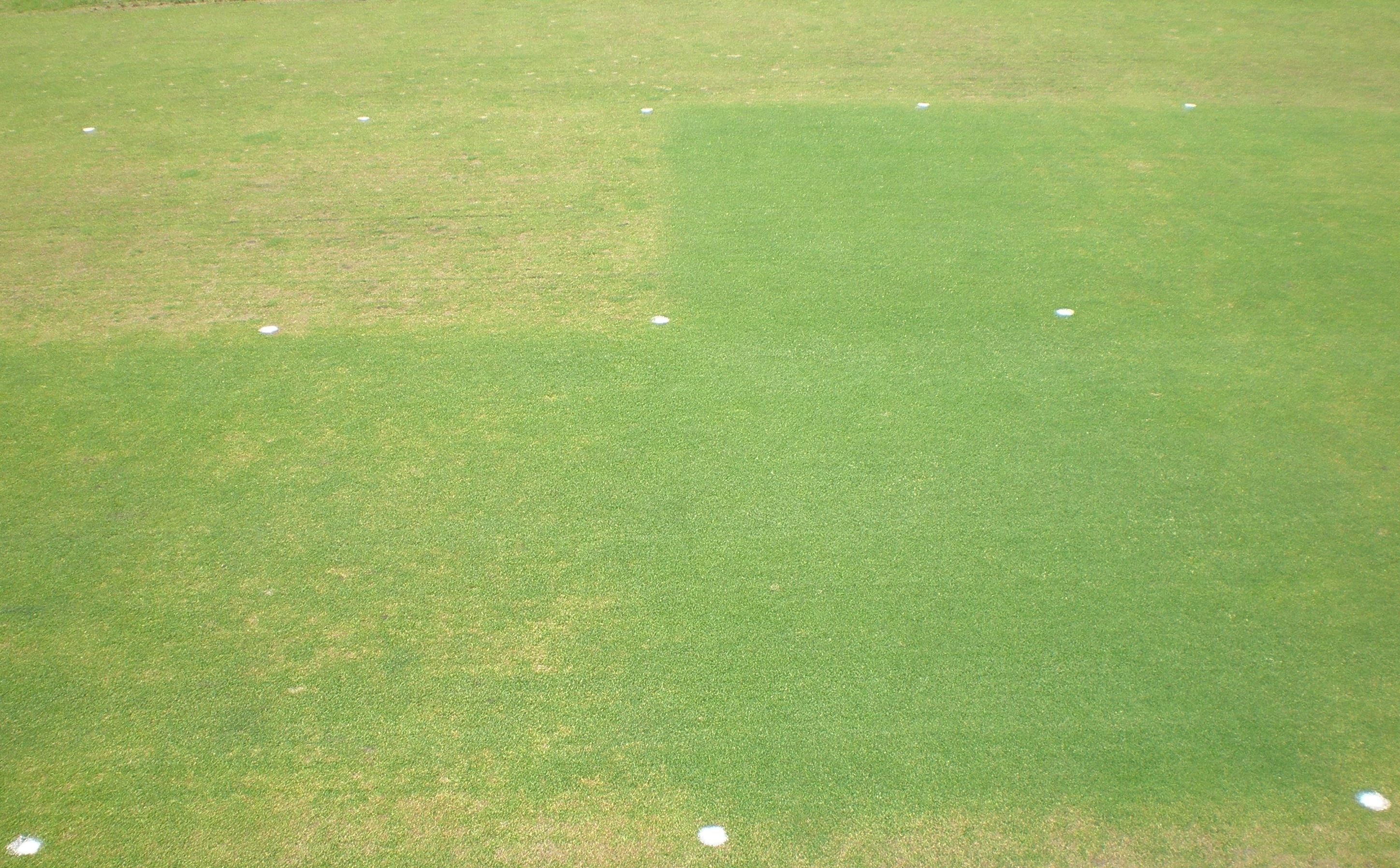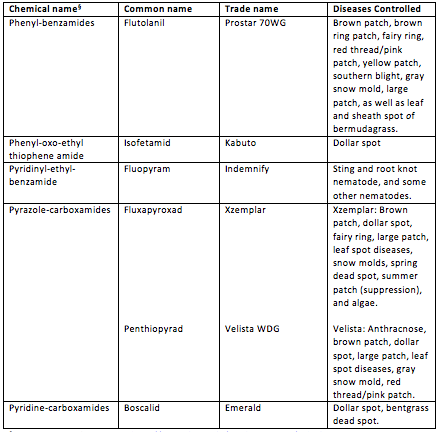SDHI Fungicides for Turfgrass Diseases
June 17, 2017 in Articles
As summer approaches, plans are being finalized for disease prevention and control programs. One group of fungicides, the succinate dehydrogenase inhibitors (SDHI), has taken a more prominent role in controlling turfgrass diseases and provides an alternative to fungicides in other mode-of-action groups for resistance management.

All SDHI fungicides have the same basic mode of action: prevention of energy production in fungal cells. Adenosine triphosphate (ATP) is a molecule present in cells of all living organisms that provides energy for essential life functions. It is produced through the transport of electrons along the respiratory chain in mitochondria. The electrons are introduced into the respiratory chain at an early stage through the activity of the succinate dehydrogenase (SDH) enzyme. SDHI fungicides bind to the SDH complex and block the transport of these electrons, energy production is curtailed, and fungal growth is arrested (Avenot and Michailides, 2010).
Active ingredients for controlling turfgrass diseases in the SDHI fungicide group
Despite having the same basic mode of action, individual SDHI fungicides differ in chemical structure and diseases controlled. Currently, there are at least 18 active ingredients that comprise the SDHI fungicides; six of these are labeled for turfgrass diseases (Table 1).
Flutolanil (Prostar, SysStar)
Flutolanil was developed in Japan by Nihon Nohyaku Co., Ltd. in the mid-1980s and is marketed in the U.S. by Bayer as the turfgrass fungicide Prostar (Anonymous, 2014). Prostar controls only diseases caused by basidiomycete fungi, such as brown patch and fairy ring (Table 1). To increase the spectrum of diseases controlled, flutolanil is mixed with thiophanate-methyl and marketed as the prepackaged mix SysStar WDG (Regal Chemical Co.), which is labeled for control of the diseases listed in Table 1 for Prostar, as well as dollar spot, anthracnose, copper spot, gray leaf spot, and pink snow mold.
Boscalid (Emerald, Honor Intrinsic)
Emerald (boscalid) was introduced in 2003 by BASF Corp. for control of dollar spot and bentgrass dead spot in turf. Although Emerald has a limited spectrum of disease control, it provides very good control of dollar spot and serves as an important resistance management tool in situations where reduced efficacy has been observed with other penetrant fungicides. BASF markets a prepackaged mixture containing boscalid and pyraclostrobin (Insignia) called Honor Intrinsic. In addition to dollar spot and bentgrass dead spot, Honor Intrinsic in labeled for many other diseases, including anthracnose, brown patch, brown ring patch, gray leaf spot, Pythium blight, and summer patch.
Isofetamid (Kabuto Fungicide SC)
Isofetamid is sold in the U.S. turfgrass market as Kabuto Fungicide SC [PBI-Gordon and Ishihara Sangyo Kaisha Ltd. (ISK)]. It was recently registered by the EPA for dollar spot control in golf turf, sports turf, and residential uses (Anonymous, 2015).

Emerald and Kabuto are important fungicides for controlling dollar spot on golf courses. Dollar spot is the #1 turfgrass disease in the U.S. with respect to amount of fungicide used.
Although Prostar, Emerald, and Kabuto are important tools for controlling specific diseases, when used alone they do not offer the broad spectrum advantages of some other SDHI products in the pyrazole-carboxamide chemical group, such as fluxapyroxad (Xzemplar) and penthiopyrad (Velista).
Fluxapyroxad (Xzemplar, Lexicon Intrinsic)
Xzemplar was recently introduced to the turf market by BASF. According to Xzemplar product literature, fluxapyroxad has improved mobility and distribution in plants when compared to earlier SDHI fungicides, such as boscalid. In addition to providing very good dollar spot control, Xzemplar is labeled for brown patch, fairy ring, large patch, snow mold diseases, spring dead spot, summer patch, leaf spot diseases, leaf & sheath spot, as well as algae for golf courses, sports turf and residential uses. BASF markets a prepackaged fungicide mixture containing fluxapyroxad and pyraclostrobin called Lexicon Intrinsic. In addition to the diseases listed on the Xzemplar label, Lexicon Intrinsic lists anthracnose, bermudagrass decline, brown ring patch, gray leaf spot, Pythium blight/root rot and several others.
Penthiopyrad (Velista)
Penthiopyrad was developed by Mitsui Chemicals Inc., and was licensed to DuPont in 2007. Penthiopyrad was registered in the U.S. in 2012 and two products, Fontelis and Vertisan, were marketed for use in the agriculture sector (Boyd, 2013). Syngenta acquired penthiopyrad from DuPont and launched Velista 50 WDG in 2014 (Jones, 2013). Velista has a broad spectrum of activity and has very good efficacy against several turfgrass diseases, including anthracnose. Mitkowski (2010) reported that penthiopyrad was more effective than eight other fungicides in inhibiting Colletotrichum cereale in vitro. The ED50 of penthiopyrad was 0.19 ppm, whereas the next most effective fungicide was approximately 3 ppm. Field trials in several locations in the U.S. have also demonstrated strong efficacy of Velista against anthracnose. Other diseases controlled by Velista include brown patch, dollar spot, large patch, leaf spot diseases, gray snow mold, and red thread/pink patch.

Velista has shown very good efficacy against anthracnose in Penn State field trials.
Fluopyram (Indemnify, Exteris Stressgard)
Fluopyram (Indemnify) is unique among SDHI fungicides in that it is labeled for nematode control or suppression in turf. The suppressive effects on nematodes were discovered by an observant scientist in Costa Rica while experimenting with soil applications for a fungal disease of banana (Anonymous, 2016). The mode of action for nematodes is the same as in fungi: blocking of cellular respiration and inhibiting ATP production. Product information highlights acropetal movement in plants (up and outward movement in xylem with internal plant water). The rate for nematode control is 0.195-0.39 fl oz/1000 ft2 at a minimum application interval of 14 days, or up to 17.1 fl oz/acre per year.
Published excerpts from an interview with Rob Golembiewski, Ph.D. of Bayer Crop Science indicate that Indemnify provides preventive and curative control of endo- and ecto-parasitic nematodes, including sting, root-knot, ring, stunt and Anguina pacificae. Research results are less clear with stubby root and sheath nematodes, and this product apparently has limited activity on lance and spiral nematodes (Throssell, 2016).
This year, Bayer launched a new fungicide called Exteris Stressgard. This combination product contains fluopyram and trifloxystrobin incorporated with Stressgard. Exteris Stressgard is formulated with a lower concentration of fluopyram than Indemnify, and will be labeled for control of anthracnose (suppression only), brown patch diseases, dollar spot, leaf spot, pink snow mold, Microdochium patch, pink patch/red thread, and rust (Throssell, 2016).
Resistance potential in SDHI fungicides:
As with most other site-specific fungicides, concern exists over pathogen resistance to the SDHI fungicides. As of this writing, I am not aware of any published reports of resistance of any turfgrass pathogen to a SDHI fungicide. However, reduced sensitivity to SDHI fungicides has been reported for several pathogens in different cropping systems, including Botrytis cinerea in various fruit crops (Yin et al., 2011 and Veloukas et al., 2011); Alternaria spp. in nut and potato crops (Avenot et al., 2008 and Gudmestad et al., 2013); and Didymella bryoniae in cucurbits (Avenot et al., 2011). Based on these reports from the agricultural sector, it’s probably just a matter of time before some degree of resistance to SDHI fungicides occurs with turfgrass pathogens.
The issue of cross resistance among the different chemical groups and active ingredients of the SDHIs appears to be more complex than with some other groups of penetrant fungicides. For example, Avenot et al. (2011) reported that some boscalid- and penthiopyrad-resistant isolates of Didymella bryoniae remained sensitive to floupyram. Likewise, in studies of boscalid control failures with early blight of potato, Gudmestad et al., (2013) found Alternaria solani isolates resistant to boscalid remained sensitive to fluopyram. Gudmestad et al. (2013) also reported isolates that were resistant to boscalid were sensitive to penthiopyrad.
Even though exceptions to cross resistance have been reported for some pathogens in certain cropping systems with selected SDHI fungicides, it is prudent to rotate use of different SDHI fungicides in golf turf, at least until more is known about how turfgrass pathogens react to repeated use of the different chemical groups and active ingredients mentioned in this article.
Table 1. Chemical name, common name, trade name, and diseases controlled for SDHI fungicides labeled for use in turf.

FRAC SDHI Working Group http://www.frac.info/working-group/sdhi-fungicides
References:
Anonymous. 2016. Revolution from the ground up. Research: The Bayer Scientific Magazine. https://www.research.bayer.com/en/revolution-from-the-ground-up.aspx
Anonymous. 2015. Kabuto Fungicide SC from PBI-Gordon receives federal registration. Superintendent. http://www.superintendentmagazine.com/the-latest/kabuto-fungicide-sc-from-pbi-gordan-receives-federal-registration/
Anonymous. 2014. Flutolanil. Wikipedia. https://nl.wikipedia.org/wiki/Flutolanil
Avenot, H.F. and T.J. Michailides. 2010. Progress in understanding molecular mechanisms and evolution of resistance to succinate dehydrogenase inhibiting (SDHI) fungicides in phytopathogenic fungi. Crop Protection 29:643-651.
Avenot H.F., A. Sellam, G. Karaoglanidis, and T.J. Michailides. 2008. Characterization of mutations in the iron-sulphur subunit of succinate dehydrogenase correlating with boscalid resistance in Alternaria alternata from California pistachio. Phytopathology 98: 736-742
Avenot H.F., A. Thomas, R.D. Gitaitis R.D., D.B. Langston Jr., and K.L. Stevenson. 2011. Molecular characterization of boscalid- and penthiopyrad-resistant isolates of Didymella bryoniae and assessment of their sensitivity to fluopyram. Pest Management Science, doi: 10.1002/ps.2311. Epub 2011 Nov 10.
Boyd, C. 2013. New product – Penthiopyrad. Chem Service News. https://www.chemservice.com/news/2013/01/penthiopyrad-fungicide/
Fungicide Resistance Action Committee (FRAC) SDHI Working Group. 2014. Introduction and general information. http://www.frac.info/working-group/sdhi-fungicides
Gudmestad N.C., S. Arabiat, J.S. Miller, and J.S. Pasche. 2013. Prevalence and Impact of SDHI fungicide resistance in Alternaria solani. Plant Disease 97: 952-960.
Jones, S. 2013. Syngenta to launch Velista in 2014. Golfdom. http://www.golfdom.com/syngenta-to-launch-velista-in-2014/
Mitkowski, N. 2010. SDHI Fungicides. University of Rhode Island Turfgrass Program Golf Course Superintendents Factsheet Series. http://www.uriturf.org/publications/urifactsheetvol6no3.pdf
Throssell, C. 2016. Closer look: Indemnify, a new nematode control product. Golfdom. http://www.golfdom.com/closer-look-indemnify-a-new-nematode-control-product/
Yin, Y.N., Y.K. Kim, and C.L. Xiao. 2011. Molecular characterization of boscalid resistance in field isolates of Botrytis cinerea from apple. Phytopathology 101: 986-995.
Veloukas, T., M. Leroch, M. Hahn, and G.S. Karaoglanidis. 2011. Detection and molecular characterization of boscalid-resistant Botrytis cinerea isolates from strawberry. Plant Disease 95: 1302-1307.
Article written by Peter Landschoot, Professor of Turfgrass Science, Dept. of Plant Science, Penn State University